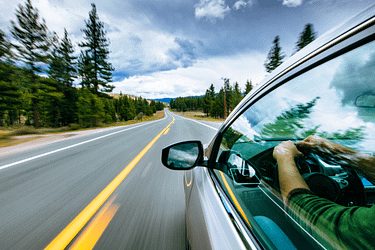Point/Counterpoint- Are Driving Restrictions Too Strict?
Yes: Driving Restrictions Can Encourage Poor Driving
Ah, yes. Driving. A sophomore’s most exciting prospect and a junior’s most anxiety-inducing test. Everyone looks forward to the day they hop in the car and drive away for the first time. No one really thinks about all of the rules associated with getting a probationary license. From the red decals to a curfew and a passenger limit there are many restrictions that are not only unnecessary, but in some cases harmful.
First of all we have the red decals. The intent behind them is good–to help police identify potential lawbreakers–but parents and teens see them differently. Not only do they create a target for the police about any new driver figuring themselves out, they also label them as young people who are more likely to be followed or accosted by criminal figures. Driving for the first few months can be nerve racking, and these decals do nothing but make it harder on the young adult.
Next is the curfew. Again, there’s a positive intention: the effect, not so much. In New Jersey, teen drivers can only get behind the wheel from 5:01am to 11:00pm. The one caveat is if the driver is on their way home from work. Not only does this inspire speeding in

teens around night time, it also penalizes anyone with other valid reasons for being out that late, such as coming back from the hospital or helping family out in an emergency.
Another issue, probably the biggest, is the passenger limit. Very few teens follow it. It’s completely unreasonable to force decent drivers to only have one passenger simply because they are young. The rule does not apply to new drivers over 21, making it an age-ist law. Any driver on a probationary license who wants to drive more than one passenger is still going to do it–it’s just a problem if they get caught.
Overall, the heavy limitations on teen drivers are too strict and need to be reconsidered.
If lawmakers are that concerned about accidents, the problem starts with allowing a teen behind the wheel after just 6 hours of driving with an instructor, not after a year of practice.
No: Driving Restrictions Are Appropriate
Most teens are very eager to receive their drivers licenses from the moment they start high school–it’s the one big thing they look forward to. The long process to reach freedom can make it seem like the restrictions are just too much.
While they might start driving at sixteen on a permit after completing the required six hours with a driving instructor (and passing a written test that is taken during sophomore year health), they are not able to drive unsupervised until they turn seventeen and pass a road test. Once they reach that seventeen mark, that sense of freedom, which they have longed for, is rewarded to them. But there is still a caveat and that’s the driving restrictions placed on young drivers.
To many teens, driving restrictions are just another thing keeping them away from absolute freedom. Some are quite bothered by them. There are many adults that agree with this as well, claiming that the restrictions are too strict and that teens need to have fun. Others, however, feel that these restrictions are necessary for the safety of teenagers on the road in hopes to avoid accidents as best as possible.
The time restriction on the probationary driver’s license (which is what you receive when you pass your road test at age seventeen) is the main issue for most teenagers. New drivers are not allowed to drive during the hours of 11:01pm to 5:00am. This places a curfew on all young drivers, no matter what their parents allow. It is easy to see why teens might be angered by this, but they must realize how significant it is. Driving during the night is much more difficult than driving during the day. Teenagers being new and inexperienced drivers, are better off staying away from the roads at night. Not only is the darkness an issue, but accidents are at a higher probability at night. Statistically, it is safer for teenagers to not get behind the wheel during the night.
Another restriction that irritates teenagers most is the passenger limit. Teenagers with a probationary license may only have one additional passenger unless accompanied by a supervising driver. Once again, it is easy to see why teens disagree with this. However, having more people in the car is a distraction that commonly leads to accidents. Distracted driving is the most common cause for accidents in the United States. While it may be fun to have more people in the car, young drivers will perform best without the added distractions. It might not seem like a hindrance but your focus can be impacted with multiple people in the vehicle.
There are likely many other restrictions that aggravate teens, but these are definitely the most prominent. What teenagers need to understand is that these restrictions were placed for their safety. So, do us a favor and honor the driving restrictions to keep you, your friends, and anyone else on the roads safe.
